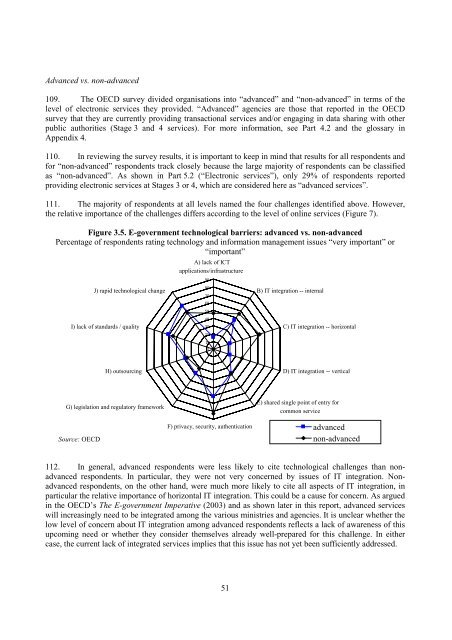e-GOVERNMENT IN FINLAND - ePractice.eu
e-GOVERNMENT IN FINLAND - ePractice.eu
e-GOVERNMENT IN FINLAND - ePractice.eu
You also want an ePaper? Increase the reach of your titles
YUMPU automatically turns print PDFs into web optimized ePapers that Google loves.
Advanced vs. non-advanced<br />
109. The OECD survey divided organisations into “advanced” and “non-advanced” in terms of the<br />
level of electronic services they provided. “Advanced” agencies are those that reported in the OECD<br />
survey that they are currently providing transactional services and/or engaging in data sharing with other<br />
public authorities (Stage 3 and 4 services). For more information, see Part 4.2 and the glossary in<br />
Appendix 4.<br />
110. In reviewing the survey results, it is important to keep in mind that results for all respondents and<br />
for “non-advanced” respondents track closely because the large majority of respondents can be classified<br />
as “non-advanced”. As shown in Part 5.2 (“Electronic services”), only 29% of respondents reported<br />
providing electronic services at Stages 3 or 4, which are considered here as “advanced services”.<br />
111. The majority of respondents at all levels named the four challenges identified above. However,<br />
the relative importance of the challenges differs according to the level of online services (Figure 7).<br />
Figure 3.5. E-government technological barriers: advanced vs. non-advanced<br />
Percentage of respondents rating technology and information management issues “very important” or<br />
“important”<br />
I) lack of standards / quality<br />
G) legislation and regulatory framework<br />
Source: OECD<br />
J) rapid technological change<br />
H) outsourcing<br />
A) lack of ICT<br />
applications/infrastructure<br />
90<br />
80<br />
70<br />
60<br />
50<br />
40<br />
30<br />
20<br />
10<br />
0<br />
F) privacy, security, authentication<br />
112. In general, advanced respondents were less likely to cite technological challenges than nonadvanced<br />
respondents. In particular, they were not very concerned by issues of IT integration. Nonadvanced<br />
respondents, on the other hand, were much more likely to cite all aspects of IT integration, in<br />
particular the relative importance of horizontal IT integration. This could be a cause for concern. As argued<br />
in the OECD’s The E-government Imperative (2003) and as shown later in this report, advanced services<br />
will increasingly need to be integrated among the various ministries and agencies. It is unclear whether the<br />
low level of concern about IT integration among advanced respondents reflects a lack of awareness of this<br />
upcoming need or whether they consider themselves already well-prepared for this challenge. In either<br />
case, the current lack of integrated services implies that this issue has not yet been sufficiently addressed.<br />
51<br />
B) IT integration -- internal<br />
C) IT integration -- horizontal<br />
D) IT integration -- vertical<br />
E) shared single point of entry for<br />
common service<br />
advanced<br />
non-advanced
















